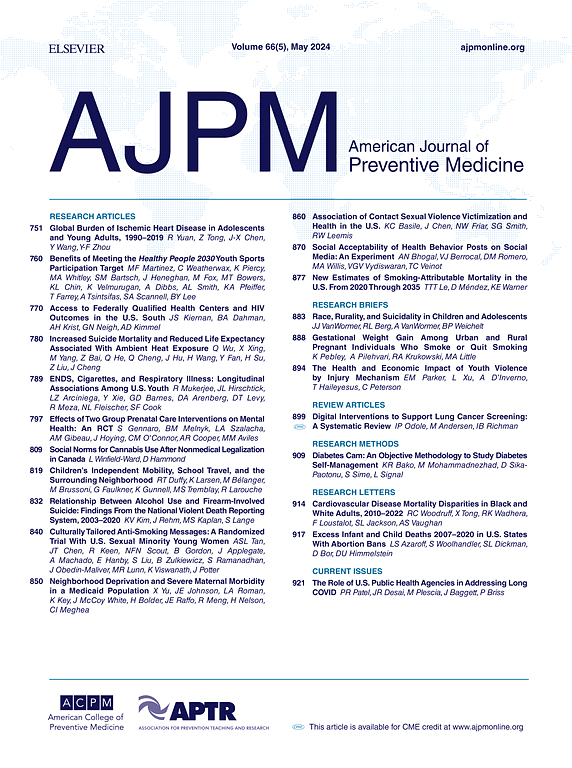Incentivizing Tobacco Helpline Engagement in Persistent Poverty Counties: A Randomized Trial
IF 4.3
2区 医学
Q1 MEDICINE, GENERAL & INTERNAL
引用次数: 0
Abstract
Introduction
Persistent poverty counties (PPCs) are U.S. counties where ≥20% of residents have lived in poverty for ≥30 years. Cancer mortality rates in PPCs are exceptionally high due, in part, to elevated smoking rates.
Study Design
The study used a parallel 2-group randomized controlled trial design.
Setting/participants
Participants were Oklahoma Tobacco Helpline (OTH) callers from PPCs who smoked daily (N=165). Data were collected in 2022–2023.
Intervention
Participants were randomized to received OTH treatment (coaching calls plus nicotine replacement therapy [NRT]) or OTH treatment + financial incentives (OTH+FI) for completing coaching calls.
Main Outcome Measures
Outcome measures included the number of coaching calls completed, call-contingent incentives earned, past 7-day self-reported abstinence rates, and study retention at 8- and 12-weeks post-enrollment.
Results
Participants (N=165) were predominantly female (63.6%), 24.2% were racially/ethnically minoritized (18.2% single- or multi-race American Indian), and they smoked an average of 21.01 (SD=11.67) cigarettes per day. Adjusted analyses indicated that participants assigned to OTH+FI were significantly more likely than those assigned to OTH to report past 7-day abstinence at the 8-week (AOR=2.28; 95% CI=1.18, 4.48) and 12-week (AOR=2.00; 95% CI=1.03, 3.96) follow-ups when missing outcomes were considered smoking. Participants assigned to OTH+FI were more likely to complete ≥3 coaching calls (AOR=3.64; 95% CI=1.84, 7.43), and they completed more total calls (aRR=1.53; 95% CI,=1.24, 1.90) than those assigned to OTH. The number of coaching calls completed significantly mediated the relationship between treatment group assignment and abstinence at the 8- and 12-week follow-ups. Overall, study retention was >83% at the 8- and 12-week follow-ups and did not differ between groups. Statistical analyses were conducted in 2024.
Conclusions
Findings support the feasibility and efficacy of offering small FI for completing OTH coaching calls to increase treatment engagement and smoking cessation in PPCs.
激励持续贫困县参与烟草帮助热线:随机试验。
导言:持续贫困县(PPCs)是指美国有≥20%的居民在贫困中生活≥30年的县。持续贫困县的癌症死亡率特别高,部分原因是吸烟率较高:研究采用平行 2 组随机对照试验设计:参与者是俄克拉荷马州烟草帮助热线(OTH)的来电者,他们每天都吸烟(N=165)。数据收集于2022-2023年:参与者被随机分配接受OTH治疗(辅导电话加尼古丁替代疗法[NRT])或OTH治疗+完成辅导电话的经济激励(OTH+FI):主要结果测量指标包括完成辅导电话的次数、获得的与电话相关的奖励、过去7天自我报告的戒断率,以及加入后8周和12周的研究保持率:参与者(N=165)主要为女性(63.6%),24.2%为少数种族/族裔(18.2%为单一或多种族美国印第安人),平均每天吸烟21.01支(SD=11.67)。调整后的分析表明,如果将缺失结果视为吸烟,则被分配到OTH+FI的参与者在8周(aOR=2.28 [95% CI, 1.18, 4.48])和12周(aOR=2.00 [95% CI, 1.03, 3.96])的随访中报告过去7天戒烟的可能性明显高于被分配到OTH的参与者。与被分配到OTH的参与者相比,被分配到OTH+FI的参与者更有可能完成≥3次通话(aOR=3.64 [95% CI, 1.84, 7.43]),完成的辅导通话总数也更多(aRR=1.53 [95% CI, 1.24, 1.90])。在 8 周和 12 周的随访中,完成的辅导电话次数对治疗组分配与戒断之间的关系有明显的中介作用。总体而言,在 8 周和 12 周的随访中,研究保留率大于 83%,且各组之间没有差异。统计分析于 2024 年进行:研究结果表明,为完成OTH辅导电话提供小额FI以提高PPCs的治疗参与度和戒烟率是可行且有效的。
本文章由计算机程序翻译,如有差异,请以英文原文为准。
求助全文
约1分钟内获得全文
求助全文
来源期刊

American Journal of Preventive Medicine
医学-公共卫生、环境卫生与职业卫生
CiteScore
8.60
自引率
1.80%
发文量
395
审稿时长
32 days
期刊介绍:
The American Journal of Preventive Medicine is the official journal of the American College of Preventive Medicine and the Association for Prevention Teaching and Research. It publishes articles in the areas of prevention research, teaching, practice and policy. Original research is published on interventions aimed at the prevention of chronic and acute disease and the promotion of individual and community health.
Of particular emphasis are papers that address the primary and secondary prevention of important clinical, behavioral and public health issues such as injury and violence, infectious disease, women''s health, smoking, sedentary behaviors and physical activity, nutrition, diabetes, obesity, and substance use disorders. Papers also address educational initiatives aimed at improving the ability of health professionals to provide effective clinical prevention and public health services. Papers on health services research pertinent to prevention and public health are also published. The journal also publishes official policy statements from the two co-sponsoring organizations, review articles, media reviews, and editorials. Finally, the journal periodically publishes supplements and special theme issues devoted to areas of current interest to the prevention community.
 求助内容:
求助内容: 应助结果提醒方式:
应助结果提醒方式:


